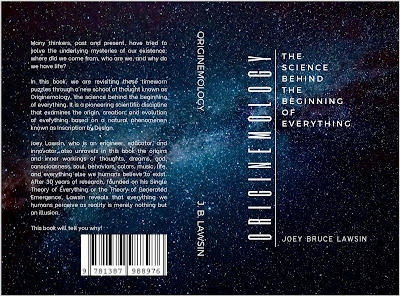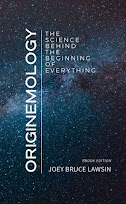I will highlight a few of the fascinating points of the research covered in the book Originemology:
Part 1. The Experimental Study on AI with Family Dogs
Part 2. The Codexation Dilemma.
Part 3. The Analysis of the Origin of the Number System.
Part 1. The Case on the Acquisition of Information:
Objective:
How is information generated and acquired by animals, in particular by Canis Familiaris?
Specimen:
1. A giant malamute (control)
2. A mini chihuahua (experimental)
Methods:
1. A newborn husky is restrained from acquiring information from his environment.
2. The research environment is controlled and restricted from people, animals, and objects.
3. The emergence of information is strictly introduced by associative learning and discovery.
4. The experimental subject is presented to another breed after a couple of years.
5. The transfer of information to the experimental subject is documented.
Data:
1. Voice recognition through waveform signature generated by an oscilloscope.
2. Transfer of information from the control subjects to the experimental.
3. List of information (eg. words, actions) acquired by association and by discovery.
Conclusion:
1. Information is acquired only in two and only two ways: by choice and by chance.
2. Information is acquired from one's own environment.
3. The mind of a newborn is completely empty of information.
4. Nature is the Mother of Information and Energy is Nature's language.
5. New Principles and Paradigms originally discovered in Originemology and its Signature Theories.
Part 2. The Codexation Dilemma:
- Please see the partial paper
here
Part 3. The Creation and Evolution of the Number System:
When I was a kid, I was deeply fascinated with numbers at a very early age I learned to count from 0, 1, 2, 3, 4, 5, 6, 7, 8, and 9 by heart. Then, the next 10 numbers ....10, 11, 12, 13, 14, 15, 16, 17, 18, 19, 20. And, the next group of ten numbers.....21, 22, 23, 24, 25, 26, 27, 28, 29, 30 .... and so forth and so on until I learned to recite each number from 1 to 100 with confidence.
However, visualizing and mastering these groups of numbers was far from easy. Well, one thing was for sure, I was not good at memorization. So I figured out a simple way of remembering these numbers. As I was writing all the numbers from 1 to 100 on a piece of paper, in groups of ten, I realized that the first ten numbers .... 0,1,2,3,4,5,6,7,8,9 .... were being used over and over again entirely on the list. This was the AHA moment. The set of ten counting numbers was the secret pattern that created the whole numerical system. It was the "genetic code" of the numeral kingdom so to speak. The "seed' in the life of the base-ten numbers.
Examination:
To show how these numbers generate ad infinitum, let us use the table matrix as shown below. In the top row, the numbers – 0,1,2,3,4,5,6,7,8,9 - are individually listed in each box. These ten basic digits serve as the seed or base. In the first column, meanwhile, the numbers listed downward are simply a guidepost or reference point. The rule of creating the numbers is simple: every number in this column will be paired with each number in the top row.
Replication:
So to produce the next 10 new numbers, the 10 numbers in the top row will be replicated on the second row. Then, from the first column, the number 1 will be paired side by side with the number 0,1,2,3,4,5,6,7,8,9. Once done, the result in the second row will now look like this: 10, 11, 12, 13, 14, 15, 16, 17, 18, 19. From the 10 counting numbers that started from 0 to 9, the set is now transformed into 10, 11, 12 ... to 19.
If the same basic set of ten numbers ... 0123456789 ... is paired now with number 2, the next new group of numbers becomes 20, 21, 22, 23, 24, 25, 26, 27, 28, 29. Thus, after counting from 0 to 19, the numbers 20, 21, 22, 23, 24, 25, 26, 27, 28, 29 come next.
As the same rule is repeated and the same numbers are used over and over again, the next group in the fourth row becomes ...30, 31, 32, 33, 34, 35, 36, 37, 38, 39. In the fifth row, the next group is 40, 41, 42, 43, 44, 45, 46, 47, 48, 49. In the sixth row, the next group is 50, 1, 52, 53, 54, 55, 56, 57, 58, 59, and so forth, and so on.
Propagation:
Therefore to create and generate new numbers and new groups, two things are needed: a set of rules and a set of numbers. From the same set of rules, numbers even evolve, propagate, and branch out into new entities and new families. They even propagate into new systems totally different from their original root or family as you will see later.
Interpretation:
Now, if instead of using 10 numbers, we use 2, 6, 8, and 16 numbers as the base of our counting system and use the same set of rules, will new numbers be created and generated as well?
Let us examine the Martian Number System. If Martians have six fingers, 3 on the right and 3 on the left, then their numerical system is made up of six numbers - 0,1,2,3,4,5. This assumption is based parallel to humans' 10 fingers that represent their 10 basic numbers. If we follow the same procedure of the base-10 system of generating numbers, the Martians matrix table will be:
From the table above, the Martian's counting system starts from 0, 1, 2, 3, 4, and 5. However, instead of the numbers 6, 7, 8, 9, and 10 following them, the numbers 10, 11, 12, 13, 14, 15 come next after 5. Instead of 16, 17, 18 and 19, the numbers 20, 21, 22, 23, 24, 25 come next after 15. Instead of 26, 27, 28, and 29, the numbers 30, 31, 32, 33, 34, 35 follow next after 25. As the same set of rules is implemented over and over again, the Martian number system evolves and propagates forever in time just like Earthling's base-10 system.
Other interesting counting systems that yield numbers infinitely are the Binary and the Maya number systems. The Binary system utilizes only two numbers, 0 and 1, instead of six or ten numbers. With these 2 numbers, it can also generate (aside from numbers) new breeds of complex families like picture elements (pixels), computer programs (software), and smart robots (hardware) to name a few. The Maya number system, on the other hand, in essence, is a binary system with a twist. It comes also with two numbers in the form of solid objects - a stone(dot) and a stick(dash). The Stone represents a dot which is equivalent to One and the Stick a dash and equal to Five. With the number Zero, it is represented by a Shell. Although sticks, rocks, shells, leaves, and fingers were originally used for counting by our ancient ancestors, these pieces eventually evolved over time into various new systems like the smoke signals, the Morse code, and the complex worldwide web with rules.
Other numerical systems, invented by the Inca civilization, the Ancient Egyptians, the Mayans, the Greeks, the Babylonians, the Sumerians, and the Chinese, also evolved and propagated by following a set of rules. With an algorithm that guided their creations and evolutions, new entities and new families also existed. From all these systems, the set of instructions is the "creator" of the numerical world. A set of instructions is commonly known as the procedure. When rules or procedure is generally applied repeatedly to different conditions with the same outcome, it becomes a Law. The creation and evolution of the number system existed because of the Law. [Lawsin, 2000, Creation by Law]
 |
| Mayan Counting System |
When I reached my teenage years, my fascination with numbers snowballed and skyrocketed to the next level. Equipped with my father’s geometry book, I learned to extrapolate postulates, axioms, theorems, corollaries, propositions, and algorithms. With all this knowledge, I discovered patterns in the origin, creation, and evolution of things like how a dot transforms into a line, then into a triangle, into a circular form, and into other dimensional figures using a set of rules. I even explored how equations were derived, formulated, and transformed into other equations, to the point I uncovered the formula for the Grand Unified Theory which was actually Newton's F=ma, the root formula from where most equations in physics originated. Even mathematical equations like pi are common laws of Nature. My infatuation with patterns and numbers even led me to formulate my own Pythagorean equation. With all of these interesting mental exercises, what caught my attention most was the fact that all the information in geometry was based on the geometrical shapes nature has already designed. The Universe is made up of shape and space. Shape and space are the building blocks that create everything and everyone. They are the root of everything. Everything started with the dualpairing of Shape and Space. (The comprehensive discussion of the theory of Space and Shape is in the book Originemology).
























